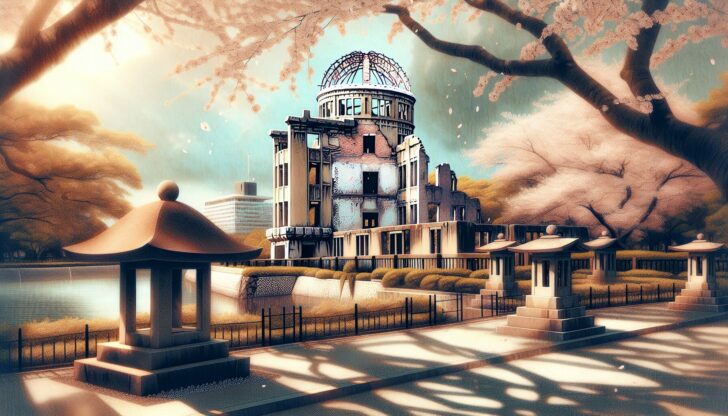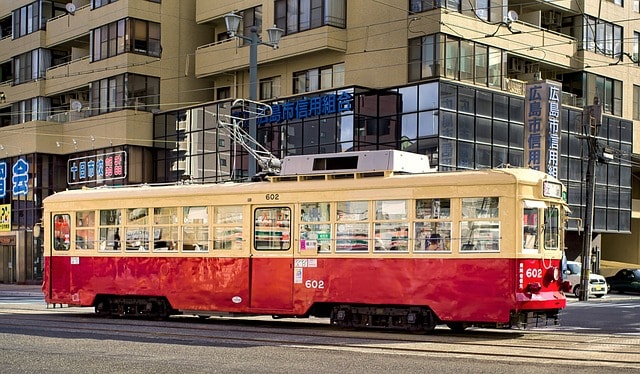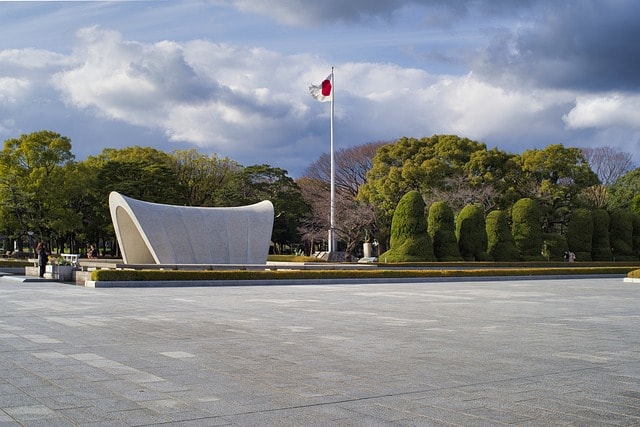The city of Hiroshima is marked by history, tragedy, and remarkable recovery. Famously devastated by an atomic bomb in 1945, it now stands as a symbol of peace and resilience. This article covers the city of Hiroshima’s journey from its past to its vibrant present.
Table of Contents
Key Takeaways
Hiroshima evolved from a small fishing village to a strategic urban center, marked by significant growth during the Meiji Restoration and industrialization periods.
The atomic bombing on August 6, 1945, caused catastrophic destruction, with immediate and long-term devastating effects, including massive loss of life and extensive city damage.
Hiroshima’s reconstruction and recovery efforts, symbolized by the Hiroshima Peace Memorial City Construction Law, transformed it into a symbol of resilience, peace, and innovation, featuring landmarks like the Hiroshima Peace Memorial Park.
From Fishing Village to Urban Center

Hiroshima’s journey began as a humble small fishing village along the serene shores of Hiroshima Bay. In the 12th century, the village flourished under the Taira clan, growing in economic prosperity and laying the groundwork for its future. Hiroshima’s transformation into a castle town on the Ōta River delta in 1589, initiated by Mōri Terumoto, marked a major turning point. The name ‘Hiroshima,’ meaning ‘Wide Island,’ was bestowed during this transformative period, highlighting its strategic importance.
The Meiji Restoration in 1868 marked a significant acceleration in Hiroshima’s growth. The 1880s witnessed a transformative development with the construction of Ujina Harbor, which established Hiroshima as an essential port city. By the late 19th and early 20th centuries, industrialization had firmly taken root, with various industrial plants and shipyards being established near the Ujina Port. Hiroshima’s strategic importance was emphasized when it served as the temporary seat of the Japanese government during the First Sino-Japanese War.
This evolution from a small fishing village to a bustling urban and industrial center is a testament to Hiroshima’s resilience and strategic importance. The city’s early foundations laid the groundwork for its future growth, setting the stage for the pivotal events that would later define its history.
The Atomic Bombing and Its Aftermath
On a fateful morning of August 6, 1945, Hiroshima City faced an unprecedented tragedy. At 8:15 a.m., the B-29 bomber Enola Gay dropped the ‘Little Boy’ uranium bomb, a devastating nuclear weapon, unleashing a blast with an estimated yield of 15 kilotons of TNT. The immediate devastation was staggering, with around 70,000 people perishing in an instant due to the immense blast and searing heat. The firestorm that ensued engulfed 4.4 square miles of Hiroshima, reducing the city to rubble.
The aftermath of the atomic bombing was harrowing. Some of the devastating effects included:
Less than 10 percent of Hiroshima’s buildings survived without damage
By the end of 1945, the death toll had risen to over 100,000
Additional lives were lost due to radiation sickness, which began manifesting in survivors just days after the bombing
Symptoms of radiation sickness peaked three to four weeks post-bombing
These effects added to the catastrophic human toll of the world war.
The destruction wrought by the atomic bomb was unparalleled, reshaping Hiroshima’s landscape and leaving an indelible mark on its history. Yet, amidst the ruins, the seeds of recovery and hope began to take root, setting the stage for Hiroshima’s remarkable journey of rebuilding and resilience.
Rebuilding and Recovery
In the aftermath of such destruction, Hiroshima’s path to recovery was a monumental challenge. The enactment of the Hiroshima Peace Memorial City Construction Law in 1949 symbolized a national commitment to the city’s reconstruction and peace. This legislation provided special assistance from the national government, catalyzing the rebuilding efforts that would transform Hiroshima from a devastated landscape into a thriving urban center once more.
The city commenced its reconstruction by focusing on the development of vital urban infrastructure. Under a comprehensive war-damage reconstruction project, plans were laid out for the city and other city areas, including:
roads
parks
green areas
extensive land readjustments
This ambitious vision, born in the aftermath of World War II, was pivotal in restoring Hiroshima’s functionality and beauty, turning it into a symbol of peace and resilience.
Despite daunting challenges, Hiroshima managed to restore essential services such as water supply to its outskirts in approximately nine months. These efforts underscored the city’s determination and the collective resolve of its citizens and government to rebuild and thrive once more.
Hiroshima Peace Memorial Park

Amidst Hiroshima’s reconstruction, the Hiroshima Peace Memorial Park, also known as the Peace Park, emerged as a central symbol of hope and remembrance. Approved in 1952, the park spans 42.7 hectares, serving as a buffer zone around the preserved Genbaku Dome, now known as the Atomic Bomb Dome. This park is a poignant reminder of the destructive power of nuclear weapons and a beacon of hope for world peace.
Dedicated to the victims of the atomic bombing, the Hiroshima Peace Memorial Park encompasses several notable features. The Atomic Bomb Dome, a UNESCO World Heritage site, stands as a stark testament to the devastation. The park also hosts the annual Hiroshima Peace Memorial Ceremony on August 6th, honoring those who lost their lives and advocating for a nuclear-free world.
Hiroshima Peace Memorial Museum
Completed in 1955, the Hiroshima Peace Memorial Museum is integral to documenting the atomic bombing and educating the public about its aftermath. The museum’s detailed exhibits offer a profound insight into the events of August 6, 1945, and their lasting impact on the city and its residents.
In addition to its exhibits, the museum hosts talks by A-bomb Legacy Successors and Hibakusha Family Member Legacy Successors, providing personal narratives that bring history to life. Guided tours by Hiroshima Peace Volunteers further enhance the educational experience, making the museum a cornerstone of Hiroshima’s peace advocacy.
Modern Hiroshima: A Blend of Culture and Innovation
Hiroshima today exemplifies a city harmoniously blending past and present. Modern Hiroshima has preserved its cultural heritage while embracing modern infrastructure and technological advancements. The city’s landscape is a blend of:
bustling roads
high-rise office buildings
vibrant nightlife
historical sites
serene parks
This unique blend of old and new is what makes Hiroshima a fascinating place to visit. The city’s resilience and innovation are evident in its dynamic urban environment, where history is not forgotten but integrated into the fabric of everyday life.
Culinary Delights: Okonomiyaki and More
Hiroshima is a culinary paradise, renowned for its delicious and unique dishes. At the heart of its gastronomic fame is okonomiyaki, a savory pancake featuring a thin layer of batter topped with a generous amount of cabbage and yakisoba noodles. Popular toppings include oysters, squid, and cheese, making each serving a delightful experience. For an immersive experience, Okonomimura offers multiple floors of restaurants dedicated to this iconic dish.
Beyond okonomiyaki, Hiroshima is also celebrated for its oysters, which constitute about 60-70% of Japan’s production. These oysters can be enjoyed raw, deep-fried, baked, or grilled, offering a variety of flavors to savor. Another local specialty is Hiroshima-style tsukemen, cold noodles dipped in a spicy red pepper sauce, perfect for those who enjoy a bit of heat in their meals.
Transportation in Hiroshima

Traveling within and around Hiroshima is made easy by its well-developed transportation system. The city is a major stop on the Sanyo-Shinkansen Line, with Shinkansen services connecting it to Tokyo in about four hours and Osaka in just 90 minutes. Hiroshima Airport facilitates both domestic and international flights, ensuring easy access from various locations.
The city’s tram network is particularly noteworthy. Despite the atomic bombing, streetcar operations resumed just three days later, highlighting the resilience of Hiroshima’s transportation system. Today, around 300 trams operate on seven main lines, providing an efficient and affordable mode of transport. The Hiroden tram network, known as the ‘Moving Museum,’ features a mix of vintage and modern trams, adding a touch of nostalgia to everyday commutes.
Additionally, ferry services connect Hiroshima to the picturesque Miyajima island, offering a scenic route to this popular destination.
Sports and Recreation
The Hiroshima Toyo Carp baseball team, which holds a special place in the hearts of Hiroshima’s citizens, exemplifies the significant role sports play in their lives. Founded in 1950, the team has a passionate fanbase, particularly among the younger population. The Carp have a storied history of success, winning the Central League pennants eight times and the Japan Series titles three times.
The current manager, Takahiro Arai, continues to build on the team’s legacy, fostering a spirit of community and pride. The team’s history of developing talented players, including notable Latino players in the 1990s, underscores its commitment to excellence and diversity.
Annual Events and Festivals
A variety of annual events and festivals celebrating Hiroshima’s rich culture and history take place in the city. The Hiroshima Peace Memorial Ceremony on August 6th is a poignant event that commemorates the victims of the atomic bombing and promotes global peace. Another highlight is the Ebisu Festival, an annual celebration in the Ebisucho area, known for its vibrant atmosphere and traditional festivities. These events showcase the diverse cultural offerings of the Hiroshima Prefectural region.
The city, located in Hiroshima Prefecture, also boasts spectacular fireworks displays, such as the Kure Fireworks Festival held every August by the city port, and the Hiroshima Port Fireworks Festival, which illuminates the bay in late July. These events, along with numerous other local festivals, provide a glimpse into Hiroshima’s vibrant cultural life and its enduring spirit.
Education and Research
Established in 1949, Hiroshima University is recognized as a cornerstone of educational excellence and research. The university’s roots trace back to several predecessor schools, each with a rich history of contributing to educational research and teacher training. Notably, Hiroshima Higher Normal School, founded in 1902, was renowned for training secondary school teachers, earning the moniker ‘head temple of regular teachers’.
The integration of these schools into Hiroshima University has fostered a robust academic environment. The university’s continuous development, including the establishment of the Graduate School of Education in 1953, has cemented its reputation as a leading institution for education and research. Today, Hiroshima University continues to innovate and contribute to various academic fields, reflecting the city’s commitment to progress and learning.
Visiting Hiroshima: Top Attractions

With a wealth of attractions, Hiroshima caters to a diverse range of interests. Hiroshima Castle, also known as Carp Castle, is a must-visit, offering historical insights and picturesque views. Miyajima Island, famous for the Itsukushima Shrine, provides a tranquil escape with its stunning natural beauty.
For those interested in modern attractions, the Hiroshima Orizuru Tower offers panoramic views and interactive exhibits on the history of paper cranes. The Mazda Museum showcases the technological advancements and history of the Mazda automobile company, headquartered in Hiroshima. Additionally, Shukkeien Garden and Hondori Street offer serene landscapes and bustling shopping experiences, respectively, rounding out the diverse array of attractions Hiroshima has to offer.
Summary
Hiroshima’s journey from a small fishing village to a symbol of peace and modern innovation is nothing short of remarkable. The city’s resilience in the face of unimaginable tragedy, its dedication to rebuilding and promoting peace, and its vibrant cultural and culinary scene make it a unique destination. Whether you are drawn by its historical significance, modern attractions, or culinary delights, Hiroshima offers a compelling blend of the past and present, inviting visitors to explore and be inspired by its story.
Frequently Asked Questions
What was Hiroshima before it became an urban center?
Hiroshima was originally a small fishing village along Hiroshima Bay, which gained economic prosperity under the Taira clan in the 12th century.
What was the immediate impact of the atomic bomb on Hiroshima?
The immediate impact of the atomic bomb on Hiroshima was the instant death of around 70,000 people and widespread destruction, leaving less than 10 percent of buildings undamaged.
How did Hiroshima rebuild after the bombing?
Hiroshima rebuilt with support from the national government through the Hiroshima Peace Memorial City Construction Law, which focused on developing urban infrastructure and parks. This allowed the city to gradually recover and rebuild after the bombing.
What are some famous foods in Hiroshima?
Some famous foods in Hiroshima are okonomiyaki, a savory pancake with cabbage and yakisoba noodles, and oysters served in various ways. Enjoy exploring the local cuisine!
What transportation options are available in Hiroshima?
Hiroshima offers a comprehensive transportation system including Shinkansen services, a tram network, Hiroshima Airport, and ferry services to Miyajima island. These options provide convenient travel within the city and to nearby attractions.









